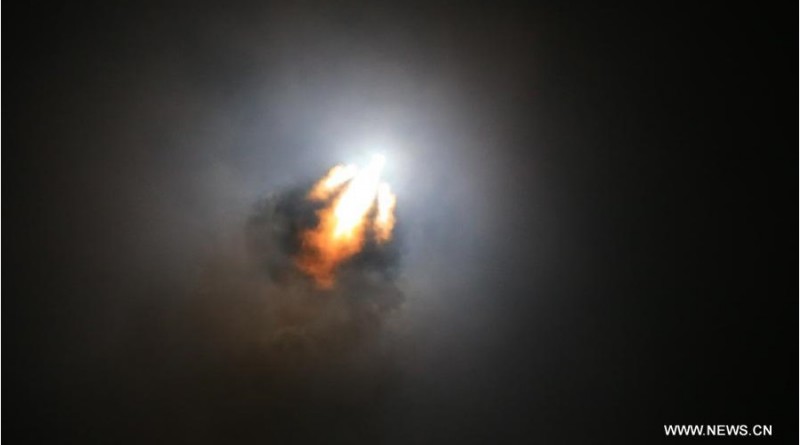China’s Long March 3B successfully delivers APStar-9 ComSat to Orbit
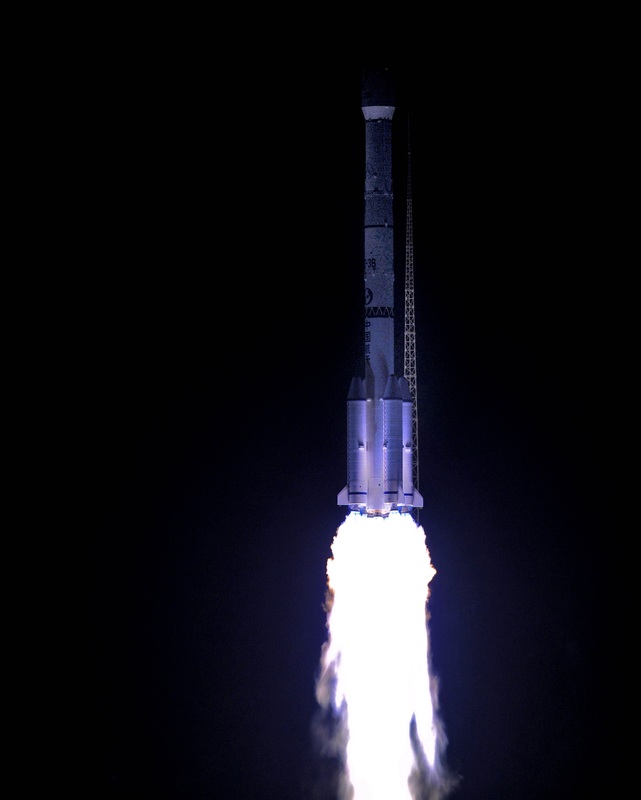
A Long March 3B/E rocket took to the dark skies over China on Friday, lifting off from the Xichang Satellite Launch Center at 16:16 UTC to deliver the APStar-9 commercial communications satellite to a Geostationary Transfer Orbit. Contracted through the China Great Wall Industry Corporation, this launch marked a rare commercial launch of a Chinese communications satellite – also the first Chinese-built satellite to enter the APStar fleet that delivers a variety of communications services to the majority of the world’s population.
Blasting off from China’s Sichuan Province, Long March 3B headed uphill under the loud thunder of its four boosters and core stage delivering a total thrust of over 600 metric ton-force. Coming just after midnight local time, the launch was accompanied by the usual reports of Earthquakes from the area as the rocket thundered to the south-east for a pass over the Chinese mainland, and the island of Taiwan before heading out over the Pacific.
Conducting a standard ascent mission to GTO, the Long March rocket fired its third stage twice for spacecraft separation approximately 26 minutes into the flight. Confirmation of launch success was provided by Chinese space officials shortly after the successful separation of the satellite occurred.
The contract for the APStar-9 satellite was signed in November 2013 as the first APT Satellite Company mission contracted to a Chinese satellite builder and launch provider. Valued at $211 million, the contract specified an October 2015 launch target, leaving less than two years for the construction of the satellite platform, the integration of the communications payload and pre-launch testing to be conducted. The satellite entered construction in October 2014 followed by the integration of the communications payload and the beginning of end-to-end testing in early 2015.
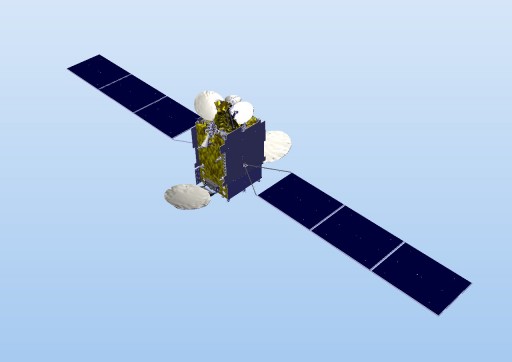
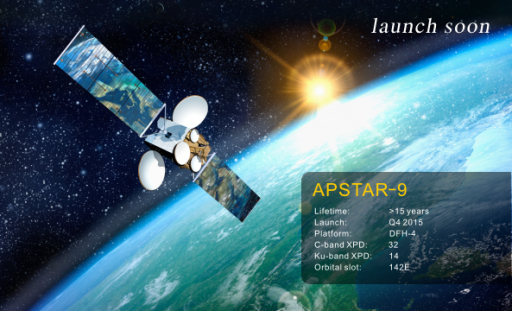
The satellite arrived at the launch site on August 27 for final processing, propellant loading and integration with the launch vehicle that had been assembled in the weeks leading up to Friday’s midnight liftoff. The launch processing team was deployed to Xichang in the second half of September, in charge of the final preparations of the launch vehicle and facility for this mission that, according to Chinese reports, will be followed in close succession by the next Long March 3B mission involving a Chinese military communications satellite.
The APStar-9 satellite has a launch mass of around five metric tons and is based on the DFH-4 satellite platform supplied by the Chinese Academy of Spaceflight Technology. DFH-4 can accommodate payloads of up to 590 Kilograms, supporting high-performance multi-band communications payloads with a total end-of-life power of 10.5kW delivered by two six-meter solar arrays. The satellite uses state of the art systems to hold its position in Geostationary Orbit with precise three-axis attitude sensing and actuation.
APStar-9 hosts 32 C-Band and 14 Ku-Band transponders. The C-Band payload generates one large beam covering the Asia-Pacific region plus one enhanced beam focused on South East Asia to facilitate video broadcasting, VSAT services and cellular backhaul. The Ku-Band system will deliver coverage to the West Pacific and eastern Indian Ocean with coverage stretching from Japan to Australia and as far east as India and Sri Lanka. The Ku system provides Direct-to-Home Television, VSAT services, mobile communications and telecommunications connectivity to sea-going vessels and airplanes.
Long March 3B/E weighs approximately 456,000 Kilograms and stands 56.33 meters tall with a core diameter of 3.35 meters. The boosters, first and second stage use storable propellants, Unsymmetrical Dimethylhydrazine and Nitrogen Tetroxide while the third stage uses cryogenic propellants, Liquid Hydrogen and Liquid Oxygen.
Liftoff was preceded by an eight-hour countdown operation during which the Long March 3B rocket was powered up and underwent final testing before heading into propellant loading on the cryogenic third stage around seven hours prior to T-0, filling the stage with 18,200 Kilograms of Liquid Oxygen and Liquid Hydrogen that were kept topped up until late in the countdown.
The boosters and two lower stages of the rocket received their propellant load before the countdown along with the attitude control system of the third stage since all these systems use storable propellants. Overall, the launcher was filled with 400 metric tons of Unsymmetrical Dimethylhydrazine and Nitrogen Tetroxide to be used by the boosters, the core stage and second stage in the first minutes of flight.
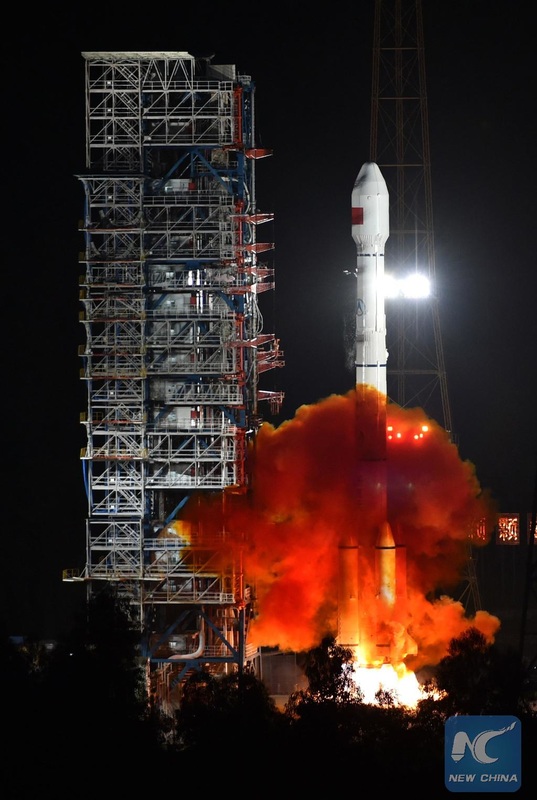
Counting down, the rocket activated its guidance systems and underwent the last steps leading up to ignition, notably the transfer to internal power and the pressurization of all tanks.
At 16:16:00 UTC, Long March 3B/E ignited its boosters and core stage that soared to a collective liftoff thrust of 604 metric-ton-force. Thundering off, the rocket rose from its pad, lighting up the night skies over the Xichang launch base in the Sichuan province in south-western China. After a vertical ascent of a few seconds, the rocket began to pitch and roll onto its planned ascent path, taking it south-east across China before passing over the Pacific Ocean.
With all engines firing at full throttle, Long March 3B/E burned 2,350 Kilograms of propellant per second as it started racing uphill and making its way downrange, passing Mach 1 and encountering Maximum Aerodynamic Pressure after passing the one-minute mark. Each of the four boosters delivered 75,500 Kilogram-force of additional thrust to the vehicle using a single DaFY-5-1 engine. The boosters consumed their propellant load of 41,200kg, each, over the course of a burn of 140 seconds. All four boosters shut down as planned and separated from the Core Stage using pyrotechnic separation mechanisms and small retrorockets to ensure a clean separation.
With the boosters gone, the Core Stage continued powering the vehicle using a DaFY-6-1 cluster of four engines delivering 302 metric tons of thrust. Overall, the 24.8-meter tall first stage launched with a propellant load of 186,200 Kilograms that was expended in two minutes and 38 seconds. Immediately after engine cutoff of the first stage, the second stage commanded its four-chamber vernier engine of the second stage to ignite as part of the hot-staging sequence employed by the Long March 3B.
A series of 14 pyrotechnic bolts were fired to disconnect the first and second stage, allowing the second stage’s vernier engine to move the stack away from the empty core stage. Moments after staging, the second stage ignited its DaFY-20-1 main engine, soaring up to a full thrust of 75,660 Kilogram-force to continue powered ascent. The second stage was controlled by using the four-chamber vernier engine that added another five metric tons of thrust. Overall, the second stage launched with a propellant load of 49,400 Kilograms measuring 12.92 meters in length and 3.35 meters in diameter.
While the second stage was firing, Long March 3B departed the dense atmosphere, making it safe to jettison the protective payload fairing and expose the APStar-9 satellite for the rest of its ride uphill.
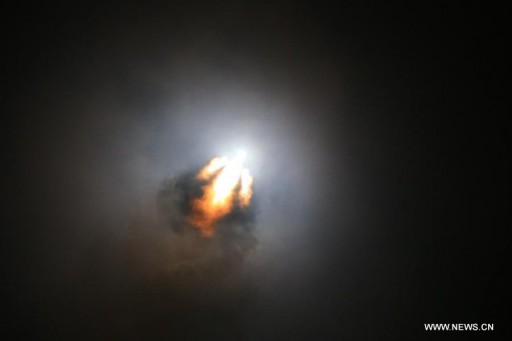
The second stage performed a nominal burn of 178 seconds with the vernier engine burning about six seconds longer than the main engine. Second stage cutoff occurred after the mission passed T+5.5 minutes. Immediately after shutdown, the pyrotechnic stage separation system was initiated and solid-fueled retrorockets moved the second stage away.
One second after staging, the third stage ignited its two cryogenic YF-75 engines. The 12.38-meter long third stage delivered a total thrust of 16,000 Kilogram-force as part of its initial burn to accelerate the stack to orbital velocity in order to enter a Low Earth Parking Orbit.
The Low Earth Parking orbit, around 190 Kilometers in altitude, was reached after a third stage burn of around four minutes and 45 seconds, marking the start of a coast phase. The coast phase, nearly 11 minutes in duration, was set up to allow the stack to fly to a position where the second burn could be performed around the equator passage so that the high-point of the orbit would be placed over the equator. This second burn lasted for approximately three minutes and 15 seconds and was followed by a variable velocity adjustment that involved the vernier engines of the third stage which continued to fire until the navigation platform sensed that the targeted injection velocity was achieved, thus optimizing the accuracy of the orbital insertion.
Separation of the APStar-9 satellite was expected just after T+26 minutes and was declared a success by Chinese officials. The achieved orbit was given as 212 by 41,965 Kilometers.
In the coming days and weeks, the satellite will complete its transfer to Geostationary Orbit and take up station at 142 degrees East where it will complete in-orbit testing and commissioning before entering operational service for a mission of at least 15 years.

